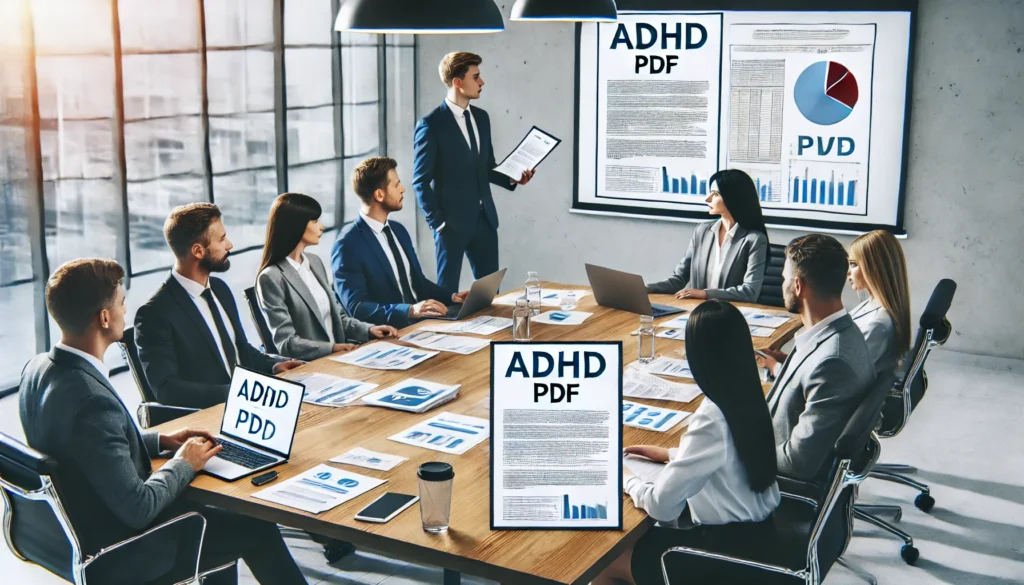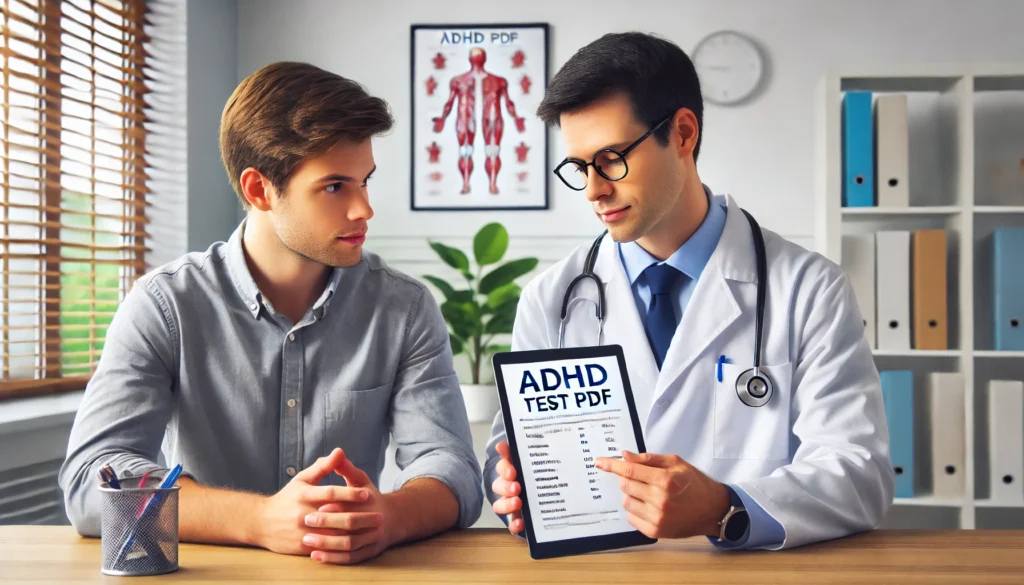Attention Deficit Hyperactivity Disorder (ADHD) is a complex neurodevelopmental condition affecting millions worldwide. Despite its prevalence, ADHD is often misunderstood, leading to misconceptions and stigma. This article delves into the intricacies of ADHD, offering insights into symptoms, diagnostic checklists, and tools for adults, all available in PDF format for ease of access and dissemination.
You may also like: Enhancing Concentration: Strategies for ADHD
Understanding ADHD: A Brief Overview
ADHD is characterized by symptoms such as inattention, hyperactivity, and impulsivity. These symptoms can manifest differently in individuals, making the disorder challenging to diagnose. Historically, ADHD was primarily associated with children, but increasing evidence shows that it persists into adulthood, impacting various facets of life, including academic performance, employment, and relationships.
Historical Context and Current Trends
The understanding of ADHD has evolved significantly over the years. Initially recognized in the early 20th century as a behavioral issue, it wasn’t until the latter part of the century that ADHD was acknowledged as a neurodevelopmental disorder. This shift marked a significant change in how ADHD was perceived and managed in both clinical and educational settings.
Recent trends highlight a more nuanced understanding, recognizing ADHD as a spectrum with varying degrees of severity and a diverse range of symptoms. This spectrum approach allows for more personalized treatment plans that can better address the unique needs of each individual. Awareness campaigns and educational programs have also contributed to reducing stigma, making it easier for individuals to seek help.
In today’s digital age, the availability of resources in PDF format has made it easier for individuals to access and share information about ADHD. PDFs offer a portable and printable option, facilitating better understanding and management of the disorder. As a result, both educators and healthcare professionals can efficiently distribute these materials to those who need them most.
The Evolution of ADHD Diagnosis
The process of diagnosing ADHD has undergone significant changes over the years. Initially, diagnosis was largely subjective, relying heavily on observational reports from parents and teachers. However, advancements in psychological testing and diagnostic criteria have led to more standardized approaches. The development of structured interviews and behavioral rating scales has improved the reliability and validity of ADHD diagnoses.
Moreover, the role of technology in diagnosis is expanding. Digital tools and apps are being used to track behaviors and symptoms over time, providing clinicians with more comprehensive data. This technological integration is helping to refine diagnostic processes and identify ADHD at earlier stages, allowing for timely intervention and support.
The Impact of ADHD on Daily Life
ADHD affects various aspects of daily life, often leading to challenges in academic, professional, and social settings. In children, ADHD can result in difficulties with schoolwork, leading to academic underachievement and increased risk of school dropout. For adults, the disorder can impact job performance, career advancement, and workplace relationships.
Social interactions can also be affected, as impulsivity and difficulty with attention can lead to misunderstandings and conflict. Individuals with ADHD may struggle with maintaining friendships and relationships, which can contribute to feelings of isolation and low self-esteem. Understanding these impacts is crucial for developing effective coping strategies and support systems.

ADHD Symptoms: What to Look For
The symptoms of ADHD are typically categorized into two main types: inattentive and hyperactive-impulsive.
Inattentive Symptoms
- Difficulty sustaining attention in tasks or play activities
- Frequent careless mistakes in schoolwork or at work
- Appearing not to listen when spoken to directly
- Avoiding or being reluctant to engage in tasks that require sustained mental effort
Inattentive symptoms are often more subtle and can be overlooked, particularly in adults. These symptoms can lead to significant challenges in environments that demand prolonged focus, such as classrooms or office settings. Individuals may be perceived as lazy or disinterested, which can exacerbate feelings of inadequacy and frustration.
The impact of inattentive symptoms extends beyond professional and academic settings. In personal life, forgetfulness and disorganization can lead to missed appointments and strained relationships. Recognizing these patterns is essential for seeking appropriate interventions and support.
Hyperactive-Impulsive Symptoms
- Fidgeting or tapping hands or feet
- Difficulty remaining seated in appropriate situations
- Talking excessively
- Interrupting or intruding on others
Hyperactive-impulsive symptoms are often more noticeable and can lead to disciplinary issues, particularly in structured environments like schools. These symptoms can result in impulsive decision-making and risk-taking behaviors, potentially leading to harmful consequences.
In social contexts, impulsivity can strain relationships as individuals may interrupt conversations or struggle with waiting their turn. Over time, these behaviors can lead to social isolation and difficulties in maintaining long-term relationships. Understanding these symptoms is crucial for both diagnosis and management.
The Importance of Early Recognition
Early recognition and intervention are key to managing ADHD effectively. Identifying symptoms at an early stage allows for timely support and can prevent the development of secondary issues such as anxiety or depression. Educators and parents play a critical role in recognizing symptoms and seeking professional guidance.
Educational programs and resources, available in PDF format, can aid in the early recognition of ADHD. These materials provide valuable information on identifying symptoms and understanding the disorder, empowering individuals to seek help and support when needed.
ADHD Checklist: Diagnostic Tools in PDF
Diagnostic checklists are invaluable tools for identifying ADHD. These checklists typically include a series of questions or criteria that help determine the presence and severity of symptoms. Available in PDF format, these checklists can be easily distributed and used by educators, parents, and healthcare providers.
Key Components of an ADHD Checklist
- Symptom Evaluation: Assessing the frequency and intensity of inattentive and hyperactive-impulsive behaviors.
- Developmental History: Understanding the onset and progression of symptoms over time.
- Behavioral Observations: Documenting behaviors across different settings, such as home, school, and work.
Symptom evaluation is a critical component of any ADHD checklist. It involves a detailed assessment of how often symptoms occur and their impact on daily functioning. This evaluation helps differentiate between normal behavior variations and clinically significant symptoms.
Developmental history provides context for understanding ADHD’s progression. By examining when symptoms first appeared and how they have changed over time, clinicians can gain insights into the disorder’s impact on an individual’s life. This history is essential for crafting effective treatment plans and interventions.
Behavioral observations offer a comprehensive view of how ADHD symptoms manifest across different environments. By documenting behaviors in various settings, such as home, school, and work, clinicians can identify patterns and triggers, leading to more tailored and effective management strategies.
Utilizing PDF Checklists for Diagnosis
PDF checklists offer a convenient and accessible way to gather information for ADHD diagnosis. These checklists can be easily downloaded and printed, allowing for widespread distribution to those who need them. Educators and healthcare providers can use these tools to facilitate discussions and assessments, ensuring a thorough evaluation process.
By utilizing these checklists, individuals can better prepare for consultations with healthcare professionals, ensuring a more accurate diagnosis and tailored treatment plan. The structured format of these checklists also helps to ensure that all relevant information is collected, minimizing the risk of overlooking critical symptoms.
The Role of Technology in Diagnostic Tools
Technology is playing an increasingly important role in the development and use of diagnostic tools for ADHD. Digital checklists and apps are being designed to streamline the data collection process, offering interactive and user-friendly options for both patients and clinicians. These tools can provide real-time feedback and analysis, enhancing the accuracy and efficiency of ADHD assessments.
Digital platforms can also facilitate communication between patients and healthcare providers, allowing for ongoing monitoring and adjustments to treatment plans. As technology continues to evolve, these innovations hold promise for improving the diagnostic process and outcomes for individuals with ADHD.

ADHD Tools for Adults: Managing the Disorder
While ADHD is commonly associated with children, adults with ADHD face unique challenges that require specific tools and strategies. Fortunately, a variety of resources are available in PDF format, designed to assist adults in managing their symptoms effectively.
Practical Tools and Strategies
- Time Management: Techniques such as prioritizing tasks, using timers, and breaking down large projects into manageable steps.
- Organization: Implementing systems for organizing workspaces, schedules, and personal belongings.
- Mindfulness and Relaxation: Practices such as meditation and deep breathing to reduce stress and improve focus.
Time management is often a significant challenge for adults with ADHD. Strategies like creating prioritized task lists and setting timers can help individuals stay focused and productive. Breaking tasks into smaller steps can make large projects feel more manageable and less overwhelming, leading to greater success in completing tasks.
Organization is another critical area where adults with ADHD may struggle. Implementing systems for organizing workspaces, schedules, and personal belongings can reduce stress and increase efficiency. Simple tools like calendars, planners, and digital apps can aid in maintaining order and keeping track of responsibilities.
Mindfulness and relaxation practices are valuable tools for managing the emotional and cognitive aspects of ADHD. Techniques like meditation and deep breathing can help reduce stress and improve concentration. These practices can be easily integrated into daily routines, providing a calming influence and enhancing overall well-being.
Building Support Networks
Creating a strong support network is essential for adults managing ADHD. Support groups and online communities offer a sense of connection and understanding, allowing individuals to share experiences and strategies. These networks can provide valuable insights and encouragement, helping individuals feel less isolated.
Family and friends play a crucial role in providing support and understanding. Open communication about the challenges of ADHD can foster empathy and patience, strengthening relationships and creating a more supportive environment. Professional support, including therapy and coaching, can also offer guidance and strategies for managing symptoms.
Leveraging Technology for Management
Technology offers numerous tools for adults with ADHD to manage their symptoms effectively. Apps and digital platforms designed for time management, organization, and mindfulness can be powerful allies in daily life. These tools can provide reminders, track progress, and offer real-time feedback, helping individuals stay on track and achieve their goals.
The integration of technology into ADHD management offers the potential for personalized and adaptive solutions. As new innovations continue to emerge, adults with ADHD have more resources than ever before to help them navigate the challenges of the disorder and live fulfilling lives.

Future Implications: ADHD Research and Innovations
The field of ADHD research is rapidly evolving, with new insights and innovations emerging regularly. Advances in neuroimaging and genetics are shedding light on the biological underpinnings of ADHD, paving the way for more targeted interventions.
Advances in Neuroimaging and Genetics
Neuroimaging technologies, such as MRI and PET scans, are providing deeper insights into the brain’s structure and function in individuals with ADHD. These advancements are helping researchers identify specific neural pathways and regions associated with ADHD symptoms. This knowledge is crucial for developing targeted treatments that address the disorder’s root causes.
Genetic research is also uncovering the hereditary components of ADHD. By identifying specific genes linked to the disorder, scientists are gaining a better understanding of its genetic basis. This research holds promise for the development of personalized medicine approaches, allowing for more precise and effective treatment options.
The Role of Digital Tools in ADHD Management
Digital tools and applications are being developed to assist individuals with ADHD in managing their symptoms. These innovations include apps for tracking symptoms, providing cognitive training exercises, and offering reminders for medication and appointments. By leveraging technology, these tools can enhance self-management and improve outcomes for those with ADHD.
Virtual reality (VR) and artificial intelligence (AI) are emerging as promising technologies in ADHD treatment. VR can provide immersive environments for cognitive training and behavioral therapy, while AI can analyze data to offer personalized treatment recommendations. These cutting-edge technologies are paving the way for more innovative and effective ADHD interventions.
Further Reading:
Exploring ADHD Symptoms and Associated Impairment Across Development
Insights into multimodal imaging classification of ADHD
Important Note: The information contained in this article is for general informational purposes only, and should not be construed as health or medical advice, nor is it intended to diagnose, prevent, treat, or cure any disease or health condition. Before embarking on any diet, fitness regimen, or program of nutritional supplementation, it is advisable to consult your healthcare professional in order to determine its safety and probable efficacy in terms of your individual state of health.
Regarding Nutritional Supplements Or Other Non-Prescription Health Products: If any nutritional supplements or other non-prescription health products are mentioned in the foregoing article, any claims or statements made about them have not been evaluated by the U.S. Food and Drug Administration, and such nutritional supplements or other health products are not intended to diagnose, treat, cure, or prevent any disease.


